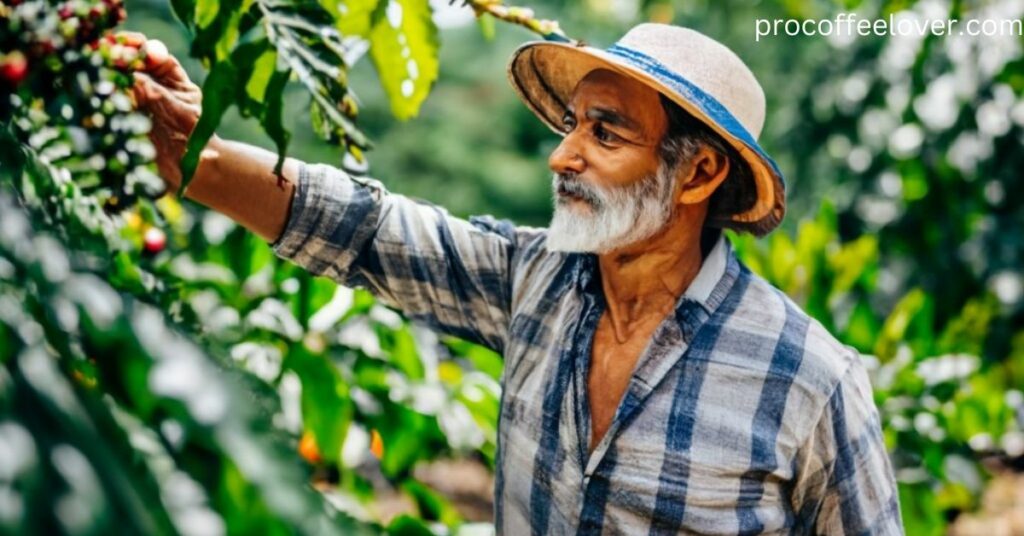Coffee is a drink prepared from the roasted seeds of the tropical evergreen coffee plant. It ranks among the top three drinks popular worldwide together with water and tea, as well as one of the most traded global economic items.
Coffee comes from Ethiopia where it grows as a coffee plant. According to legend, it was found by a goat herder who tasted its berries and felt energetic. A berry with some caffeine thus contributed to this effect.
Coffee is mainly grown in Latin America and Africa. It makes sense that Brazil is the biggest producer of coffee in the world. There are two main types of coffee plants, namely, Arabica and Robusta coffee.
Each coffee plant gives a unique flavor to your coffee, but the soil you’re growing it in, the type of climate, and even your farmer play their role as well. Coffee brews more than a morning routine; it is a worldwide trekking experience.
This exploration explores the origin of coffee, and in particular the question Where Does Coffee Come From? Let’s go through the origin of man’s most delicious drink.
Who Invented Coffee
The world’s coffee has roots that go back centuries in Ethiopia’s ancient coffee forest on the plateau land. Legend has it that a goat’s keeper called Kaldi was the first discoverer of the amazing qualities of today’s famous beans over there.
Legend has it that Kaldi found out about coffee while watching his goats fail to sleep after eating a particular tree’s berries. Kaldi told the local monastery about what he had discovered after making a drink from those berries.
He said that it helped keep him awake all through the evening praying period. He informed the other monastics in the monastery about the berries and the news about them started circulating.
Word moved east, while coffee came to the Arabian Gulf. It was the beginning of the process which brought those coffee beans to the entire world.Also see more about Dutch Bros Vs Starbucks.
The History Of Coffee

In the 15th century, wild coffee plants most likely from Kefa (Kaffa) Ethiopia were transplanted into southern Arabia. They were eventually domesticated there.
The legend about the discovery of coffee is based on Kaldi, an Arab goatherd who could not understand why his animals behaved strangely. Supposedly, around 850 CE, Kaldi tasted the berries from a shrub that the goats ate and experienced some degree of invigoration.
During the 16th and 17th centuries, coffee was spread, one country at a time, into Europe. There exist many records on whether it was allowed or banned as a religious, political, or medical drug.
By the close of the seventeenth century, there were plenty of coffeehouses all over Britain,. Then they extended to American colonies, and parts of continental Europe.
It should be noted that until the end of the 17th century, the coffee produced in the whole world was procured almost completely from the province of Yemen in southern Arabia.
However, as the drink became more popular, the propagation of the plant spread to Java island. After that it spread to other parts of the Indonesian Archipelago during the 17th century and later on to the Americas in the 18th century. In 1825, coffee cultivation was initiated on the Hawaiian Islands.
The highest levels of production were found in the western hemisphere, especially Brazil by the beginning of the 20th century. During the late 19th and early 20th century, industrial roaster grinders, vacuum seals for roasted coffees, and decaffeination methods for green coffee beans appeared.
Subsequently, after 1950, instant coffee was perfected. Then more production of Robusta coffee beans was done in Africa due to its cheaper price.
Where Did Coffee Originate
Legend has it that a 9th-century Ethiopian goat herder discovered coffee and was made stimulated. Coffee was taken to the Arab world in the fifteenth century where it was planted for trading purposes.
In the fifteenth century, wild coffee plantations were carried from the Kafa-Keffa region and grown into cultivars in the south of Arabia. Coffee became popular in the Arab world. As a result, coffeehouses were established first in Mecca and then in Constantinople during these centuries respectively.
The 16th and 17th centuries saw the introduction of coffee into one European country after another. It was by then that Europe adopted coffeehouses. Coffee is today enjoyed as a globally treasured drink that has a rich back history and different tastes to it.
Why Does The Region Matter?

Regarding coffee, the region plays a very crucial role, affecting the taste, quality, and character of the beans greatly. Coffee plants grow differently depending on the environment such as the altitude, climate, and quality of soil in respective regions influencing the ultimate end products’ flavors.
The beans carry distinct nuances that are characteristic of regions that have distinct seasons. An example is that Ethiopian coffee is commonly described as fruity or having a wine-like note. Whilst Columbian coffee shows a more balanced flavour.
In addition, the cultivation procedures used in the region affect the final products. Further, because of regional knowledge, processing methods, and varietals, the world has different and exciting coffee experiences worldwide.
Where Does Coffee Come From?
The coffee plant comes from Ethiopia. It is through these areas that coffee started moving from Ethiopia to other countries like those found in the African continent, Asia, and Latin America. Coffee is today grown along the line known as the coffee belt.
It extends around the equator; namely, within latitudes encompassed by the tropics of Cancer and Capricorn. During the daytime, it’s hot and sunny in this region but the temperature declines by nighttime.
It also rains sufficiently that the coffee can be roasted adequately. Coffee grows in regions that encompass the equator, especially in mountainous parts.
Berries grow slowly at higher altitudes resulting in a high-quality brewed coffee product. Have you ever known that coffee grown in the highlands contains relatively small amounts of caffeine?
Where Does Coffee Come From In The World?

Interestingly, coffee has an interesting worldwide genesis which started in Ethiopia. A goat herd was said to have found and consumed coffee beans in the ninth century. He discovered its stimulant properties.
Coffee cultivation was adopted in the 15th century by the Arab world and it remained a major trading product. Coffeehouses were already abundant in Europe by the 17th century.
Coffee is globally grown in various parts today with unique characteristics and flavors. Smooth Balanced coffees from Latin American countries like Colombia contrast with fruity and floral notes from Ethiopia. It spans continents in showcasing how diverse, yet united, the world sources are of coffee’s richness.
Also,see more about best Cuban coffee maker.
FAQ
Where Did Coffee First Originate?
Ethiopia is the land of origin for coffee with a legend that speaks of one 9th-century goat herder who discovered it.
How Did Coffee Spread Globally?
By the 15th century, coffee had grown and it became an important commodity trade in the Arab world. In the 17th century, coffee houses in Europe brought it to prominence.
What Does The Region Have To do With Coffee Production?
These include aspects like climate, elevation, and soil, which in turn affect coffee flavor, aroma, and overall quality.
Which Are Some Of The Known Coffee-Producing Areas?
Smooth well-balanced coffees are available in countries like Colombia. While Ethiopians have more unique fruity and floral flavors.
What Has Been The Role Of The Global Journey Of Coffee In Making i
It Diverse?
The world is now filled with many varieties of coffee cultures, the kinds of flavors, and ways of processing them
How Farmers Grow Coffee
Coffee farming is a complex process that epitomizes skills exhibited by coffee farmers globally. This takes us to a stage where one has to choose the right location. As these include climate aspects such as altitude, climate, and soil.
These factors contribute significantly to the coffee plant’s health. Coffee is usually cultivated in areas with clearly distinguishable rainy and dry spells. The process of growing coffee seeds involves farmers very cautiously planting seeds or seedlings. Then raising them to full growth, which might take up to a few years.
The coffee plants reach maturity and develop these tiny, scented blossoms which later transform into coffee berries. Ripe cherries must be harvested with care as they are hand-picked to maintain perfection.
How the coffee beans are obtained in the form of strip picking or selective picking affects their quality. After harvest, the beans go through a series of steps that include the removal of the external layer to reveal the actual cherries.
Thereafter, the beans dry up either naturally or mechanically and are carefully graded. The artistry of the growing process requiring devotion and intelligence is illustrated by this route from the nurseries to a final cup of coffee that is savored around the world among coffee enthusiasts.
Does coffee Come From Poop?
Yes, there is even an unusual kind of coffee commonly called civet coffee also referred to as kopi luwak which involves a peculiar procedure. A civet is a small mammal known for eating coffee cherries which contain excreted beans.
After these beans, they are collected, washed, and processed to come up with coffee. It is thought that fermentation that takes place in the civet’s digestive system has an effect on the beans and causes unique and very popular coffee.
Although such practice takes place, it is narrow and insignificant from the overall perspective of the coffee market. Majority of coffee undergoes conventional growing which involves handpicking the beans from the tree and processing them by traditional methods.
What Is The Origin Of Coffee Beans?
Coffee beans originate from the highlands of Ethiopia. A common tale holds that during the 9th century, a goat herder by the name of Kaldi observed an increase in the liveliness of his goats who ate berries off a particular shrub.
Upon tasting those berries, Kaldi was also overwhelmed by similar feelings of increased energy. It spread all over. It led the monks to drink it so that they would not lose concentration while engaging in prolonged prayers.
Coffee was cultivated in the Middle East by the 15th Century, and its trade became global. Coffee beans are an important part of a journey that started in Ethiopia as one of the main global beverages.
Conclusion
In conclusion, the study “Where does coffee come from” presents an exciting trip from the Ethiopian elevations to become a worldwide beverage. Coffee’s origins tell a narrative marked with myths, traditions, and world commerce.
Geography impacts coffee profiles in that some flavors are in regions like Colombia and Ethiopia. The story of coffee tells how it has passed from competent farmers’ hands into the cups of coffee lovers throughout history.
Knowing how this favorite drink started helps us admire the work behind it more; for each sip we take, we also enjoy the story that is part of its creation.
